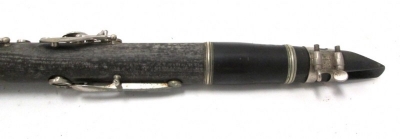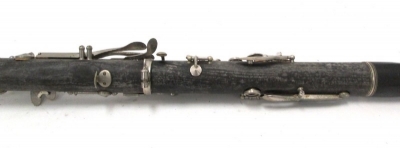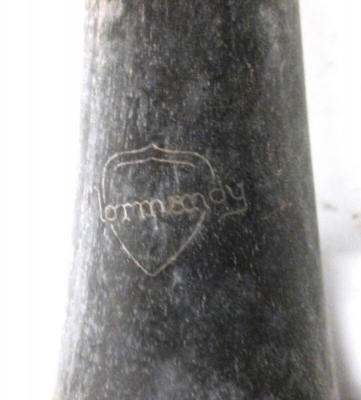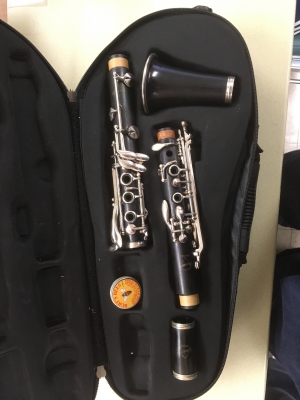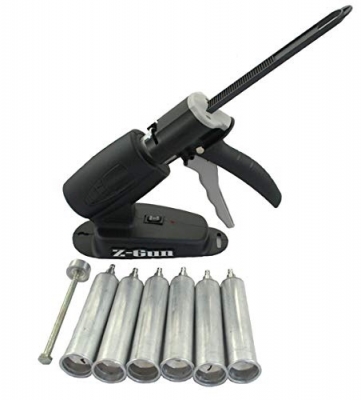Welcome to our forum. A Message To Our New and Prospective Members . Check out our Forum Rules. Lets keep this forum an enjoyable place to visit.
Currently working on errors from the latest (SimplePress) forum update. Many issues have been resoled and others are being worked on. Thank you for your patience.
 Topic RSS
Topic RSS



 (0 votes)
(0 votes) Regulars
 Offline
Offline

Unlike violins, there is little love for old wood clarinets. They command a very low price.
A teenage boy in my wood carving class (I am a fellow beginning student) really wants to learn the clarinet and I thought it would be fun to attempt to renovate the cheapest (and hence worse conditioned) wood clarinet I could find. The object of our crimes is a French “Normandy” Bb wood clarinet with a bad case of mildew. I bought it for $11. I have no prior experience in doing this and will rely on gaining knowledge from the Internet as it exists and engineering first principles to fill the gaps. I am buying a duplicate of every tool needed for the work so that the boy may start something like “MAD String Works” for woodwinds.
I thought it would be fun to blog the course of the work here. And away we go.
Success is the progressive realisation of a worthy ideal. —Earl Nightingale.
Regulars
 Offline
Offline

Regulars
 Offline
Offline

Keeping the various keys and linkages sorted during disassembly required the use of two paper egg cartons (one for each section) and sequential camera shots. I used a Wiha 2.5 mm slotted screw driver to remove the rods and pivot screws ( I needed to slightly reduce the slot by means of a diamond knife sharpener). I kept the rods on their respective keys and kept the pivot screws on their respective posts. I managed to remove them all without damaging any of the slots.
Once free of all the keys and linkages, I removed the mildew with Simple Green applied with a cotton cloth (exterior) and a duck feather (bore). Rusted post springs were treated with Extend (a Locktite product), which did a very good job. Almond oil was applied to the wood with a water colour brush (exterior) and a duck feather (bore). Three daily treatments were performed. A Krylon 18K Gold Leafing Pen was used on the engraved logos. Excess gold leaf was removed with ethanol applied with a paper coffee filter.
I would like to try the application of oil by wrapping the wood with oil soaked paper towels and treat in a pressurised air tank at 10 atmospheres.
Success is the progressive realisation of a worthy ideal. —Earl Nightingale.
Regulars
 Offline
Offline

The standard method for detecting pad seal is by use of a “rolling paper” inserted in various areas of the seal. Having a teen aged boy purchase this item is not an option. A piece of Mylar balloon should work. A more high tech approach would be the reverse engineer an electro mechanical leak detector (see below photo). Parts on order.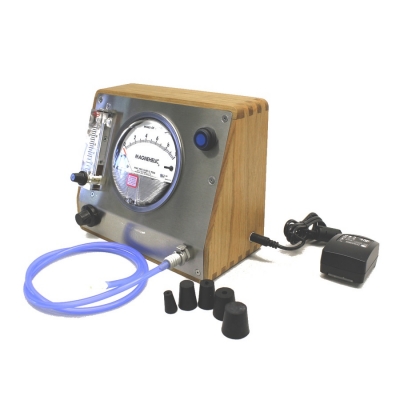

Success is the progressive realisation of a worthy ideal. —Earl Nightingale.
Regulars
 Offline
Offline

I just completed making two leak detectors, using recycled clarinet cases. The prime mover is a battery powered aquarium air pump. I purchased and installed, but did not use, an expensive ($30 each) variable air pressure relief valve. A simple orifice that was teed of the supply air line was much easier to use. I have enclosed a photo of tubing sequence. It works very well.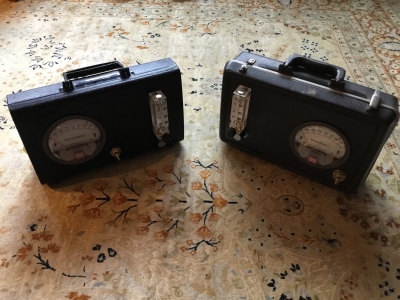

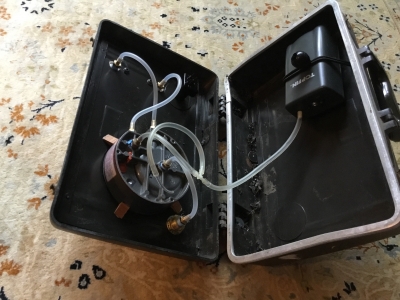

Success is the progressive realisation of a worthy ideal. —Earl Nightingale.
Regulars
 Offline
Offline

Cork sheet is the standard material for making clarinet section tenon gaskets. It is surprisingly expensive, particularly when various thicknesses are needed. I decided to experiment with karropak gasket material produced by the Federal-Mogul Corp. It takes more effort to sand down than cork, so it should last longer. The joints were made using conventional contact cement.
Success is the progressive realisation of a worthy ideal. —Earl Nightingale.
Regulars
 Offline
Offline

About half of the keys are secured with pivot screws. I am trying to reduce friction by putting Teflon tape bits in the pivot dimples. Easier said than done.
The other half of the keys have internal rods. I am cleaning out the rods and mating tubes with naphtha (lighter fluid), absorbed on a pipe cleaner for cleaning the tubes. Grime and dirt is an effecting lapping compound, and a surprisingly large amount of debris is present.
I am placing a drop of Lucas oil stabiliser on the threaded end of each rod before insertion into the post.
Success is the progressive realisation of a worthy ideal. —Earl Nightingale.
Regulars
 Offline
Offline

Used the leak detector for the first time last night.
I can see how this would be a wonderful tool for a music teacher. In a few seconds, it is possible to see if a clarinet (or flute) has any leaks. It is more problematic when used to “seat in” individual pads, since I had to remove all of the keys (filling in their respective tone holes with various sizes of silicone “stoppers”) before securing the test key/pad. The entire clarinet took about 45 minutes to test. About half of the pads seated perfectly without the need for any adjustment. I was not able to “float” about 3 pads using the application of a few seconds of a butane flame on the key since I think the pads were too thin (purchased some aluminum rivet washers today to see if I can shim them into working). The remainder were floated to the satisfaction of the device.
I am sure that the tester enabled me to do a much better job.
Success is the progressive realisation of a worthy ideal. —Earl Nightingale.
Regulars
 Offline
Offline

Aluminum washers did not work. Got all but one pad to work using conventional methods. Ordered correct size pad using formula key outside diameter in mm minus 0.3 mm equals pad size in mm. Pads currently on a slow boat from China.
Noticed that a shellac adhesive is used to seal a fountain pen bladder. I am wondering if this could be used to paste shellac onto pad and key cup instead of a shellac stick (which tends to make a mess due to my inexperience). Ordered some to try out.
Success is the progressive realisation of a worthy ideal. —Earl Nightingale.
Regulars
 Offline
Offline

The previously moldy Normandy wood clarinet is complete except for an 11.5 mm pad (currently being shipped from China). I made a temporary pad using “silly putty” covered with a couple of layers of Teflon tape. I sprang $15 for a used “first act” cloth case, which was twice the price of the clarinet.
Two investments that I need to make to continue with this hobby is a good work light, ideally incorporating a magnifying glass. Those pivot screws are very small. I also need a shallow tub like working surface to contain the small parts. I had to work very slowly to maintain inventory control. Realistically, the loss of one part junks the entire mechanism.
The only improvement I need to make is a more suitable buffing compound for polishing the metal keys. My “harbor freight” material left areas of black residue which needed to be removed by scrubbing with solvent.
Success is the progressive realisation of a worthy ideal. —Earl Nightingale.
Regulars
 Offline
Offline

I am strongly considering making a wand style steam cleaner from a recycled expresso machine to remove accumulated excretions euphemistically called “lime.” That should not be too difficult or expensive. The device could also be used to Sterilize mouth pieces and cases.
I also have the tooling and gauging necessary to adjust the opening of a mouth piece. I have certainly accumulated enough examples to form a database across manufactures. It would be a hoot to modify low cost cecilio acrylic mouthpieces to mimic the more expensive brands.
Success is the progressive realisation of a worthy ideal. —Earl Nightingale.
Regulars
 Offline
Offline

Regulars
 Offline
Offline

@Mouse. Thank you. I have read that hard rubber is an excellent material for a clarinet in that it is immune from changes in humidity. He is currently stripping the keys off of one of those now. I believe that it is a peddler, which was made in Rhode Island.
In route is a silver plated brass clarinet, which were popular circa 1910. I thought it would be a hoot if he brought one of those on the occasion of his first lesson.
Success is the progressive realisation of a worthy ideal. —Earl Nightingale.
Regulars
 Offline
Offline

@Mark . He sure was. Although I should have known better, it was amazing to me how much abuse and neglect good wood can take and come back to very close to new condition. Actually, I found and corrected a flaw in the key work mechanism so the clarinet now plays better than when it left the factory.
I found a style of ligature which is made out of braided cord. I think he could make those as well. 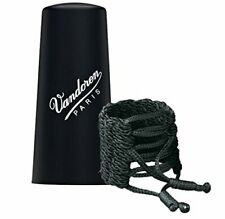
Success is the progressive realisation of a worthy ideal. —Earl Nightingale.
Regulars
 Offline
Offline

Schellac comes in the form of very thin flakes. Converting the flakes into a usable stick for melting onto pads is a messy process involving a butane torch. Not kid friendly. Since the melting point of schellac is 167 F (75 C), I reasoned that boiling water could be deployed to convert the flake into a stick.
I poured schellac flakes into 5 ml plastic syringes (consolidating the flakes with a wood pencil in about three lifts), then sealed in aluminum foil envelopes. The envelopes were placed in a container of rolling boil water, secured by the overburden of a ceramic plate. An envelope was removed and examined after 2, 4, and 6 minutes. It was determined that the flakes melted into a rod in 6 minutes, occupying about a third of the volume of the flakes. Once cooled, the rod was easily removed from the syringe since the schellac did not adhere to the plastic walls (it did tenaciously attach to the plunger).
The heat was too low to cause damage to the plastic.
I resealled the two previously unmelted syringes and repeated the boiling for 10 minutes. Upon removal from the water, I consolidated the schellac by expelling air with the plunger. See photo below.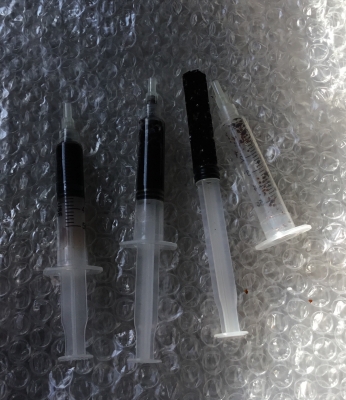

Success is the progressive realisation of a worthy ideal. —Earl Nightingale.
1 Guest(s)


 Log In
Log In Register
Register






